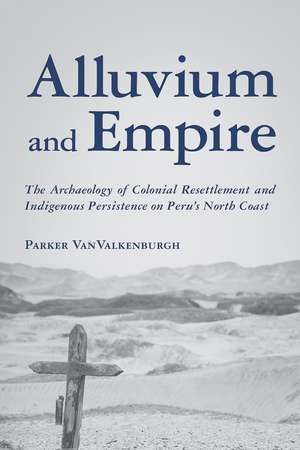Alluvium and Empire: The Archaeology of Colonial Resettlement and Indigenous Persistence on Peru’s North Coast: Archaeology of Indigenous-Colonial Interactions in the Americas
Autor Parker VanValkenburghen Limba Engleză Hardback – 18 mai 2021
Alluvium and Empire uncovers the stories of Indigenous people who were subject to one of the largest waves of forced resettlement in human history, the Reducción General. In 1569, Spanish administrators attempted to move at least 1.4 million Indigenous people into a series of planned towns called reducciones, with the goal of reshaping their households, communities, and religious practices. However, in northern Peru’s Zaña Valley, this process failed to go as the Spanish had planned. In Alluvium and Empire, Parker VanValkenburgh explores both the short-term processes and long-term legacies of Indigenous resettlement in this region, drawing particular attention to the formation of complex relationships between Indigenous communities, imperial institutions, and the dynamic environments of Peru’s north coast.
The volume draws on nearly ten years of field and archival research to craft a nuanced account of the Reducción General and its aftermath. Written at the intersections of history and archaeology, Alluvium and Empire at once bears witness to the violence of Spanish colonization and highlights Indigenous resilience in the aftermath of resettlement. In the process, VanValkenburgh critiques previous approaches to the study of empire and models a genealogical approach that attends to the open-ended—and often unpredictable—ways in which empires take shape.
The volume draws on nearly ten years of field and archival research to craft a nuanced account of the Reducción General and its aftermath. Written at the intersections of history and archaeology, Alluvium and Empire at once bears witness to the violence of Spanish colonization and highlights Indigenous resilience in the aftermath of resettlement. In the process, VanValkenburgh critiques previous approaches to the study of empire and models a genealogical approach that attends to the open-ended—and often unpredictable—ways in which empires take shape.
Preț: 385.96 lei
Nou
Puncte Express: 579
Preț estimativ în valută:
73.86€ • 78.97$ • 61.58£
73.86€ • 78.97$ • 61.58£
Carte disponibilă
Livrare economică 27 martie-10 aprilie
Livrare express 12-18 martie pentru 43.13 lei
Preluare comenzi: 021 569.72.76
Specificații
ISBN-13: 9780816532636
ISBN-10: 081653263X
Pagini: 328
Ilustrații: 13 b&w illustrations, 24 maps, 2 tables
Dimensiuni: 152 x 229 x 25 mm
Greutate: 0.64 kg
Editura: University of Arizona Press
Colecția University of Arizona Press
Seria Archaeology of Indigenous-Colonial Interactions in the Americas
ISBN-10: 081653263X
Pagini: 328
Ilustrații: 13 b&w illustrations, 24 maps, 2 tables
Dimensiuni: 152 x 229 x 25 mm
Greutate: 0.64 kg
Editura: University of Arizona Press
Colecția University of Arizona Press
Seria Archaeology of Indigenous-Colonial Interactions in the Americas
Notă biografică
Parker VanValkenburgh is Stanley J. Bernstein Assistant Professor of Social Sciences in the Department of Anthropology at Brown University. He has co-edited the volumes Arqueología Histórica en el Peru and Territoriality in Archaeology.
Recenzii
“VanValkenburgh has written a creative synthesis of his rigorous research into life in the Zaña Valley before, during, and after reducción. This book is about how humans and non-humans constituted empire on the north coast of present-day Peru, yet his novel genealogical approach should appeal to scholars working far from the Andes."—Andrew Roddick, co-editor of Knowledge in Motion: Constellations of Learning Across Time and Place
“This book represents a much-welcome approach to the archaeology of empire. It combines a sophisticated theoretical framework with rigorous archival and archaeological methods to shed valuable new light on the history of Spanish empire building in Peru.”—Craig Cipolla, author of Foreign Objects: Rethinking Indigenous Consumption in American Archaeology
“This book represents a much-welcome approach to the archaeology of empire. It combines a sophisticated theoretical framework with rigorous archival and archaeological methods to shed valuable new light on the history of Spanish empire building in Peru.”—Craig Cipolla, author of Foreign Objects: Rethinking Indigenous Consumption in American Archaeology
Descriere
Alluvium and Empire examines the archaeology of Indigenous communities and landscapes that were subject to Spanish colonial forced resettlement during the sixteenth century. Written at the intersections of history and archaeology, the book critiques previous approaches to the study of empire and models a genealogical approach that attends to the open-ended—and often unpredictable—ways in which empires take shape.














